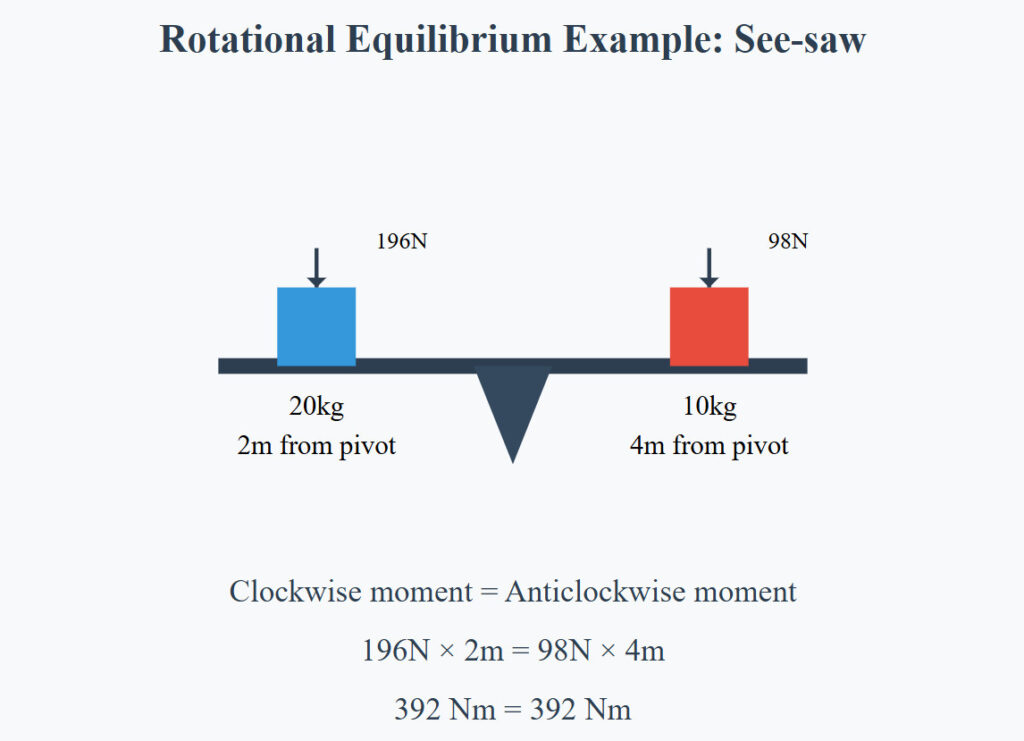Momentum is a fundamental concept in physics that helps us understand how objects move and interact with each other. Think of it as the “strength of motion” – the more momentum an object has, the harder it is to stop it! When combined with principles of equilibrium, we can understand both linear and rotational motion.
1. What is Momentum? #
Momentum is a measure of how difficult it is to stop a moving object. It depends on both the mass of the object and how fast it’s moving.
Key Points About Momentum: #
- Definition: Momentum is the product of an object’s mass and its velocity
- Symbol: We use ‘p’ to represent momentum
- Unit: kg⋅m/s (kilogram meters per second)
- Direction: Momentum is a vector quantity – it has both size and direction
2. Principle of Conservation of Momentum #
One of the most important principles in physics is that momentum is always conserved in a closed system – it cannot be created or destroyed, only transferred between objects.
Examples of Conservation of Momentum: #
- Collisions: When two objects collide, their total momentum before the collision equals their total momentum after the collision
- Explosions: When something explodes, the pieces move in different directions, but their total momentum remains zero
- Rocket Propulsion: A rocket moves forward by pushing gas backward – total momentum stays constant
3. Momentum Equation #
The basic equation for momentum is simple, but it’s very powerful for solving physics problems.
Important Things to Remember: #
- If velocity doubles, momentum doubles
- If mass doubles, momentum doubles
- An object at rest (v = 0) has zero momentum
- Momentum can be positive or negative, depending on direction
4. Equilibrium and Rotational Forces #
Equilibrium is a state where all forces acting on an object are balanced, resulting in no net movement. This applies to both linear forces and rotational (turning) forces.
Understanding Equilibrium: #
- Linear Equilibrium: All forces balance out (sum of forces = 0)
- Rotational Equilibrium: All turning forces balance out (clockwise moments = anticlockwise moments)
- Moment: The turning effect of a force (Force × perpendicular distance from pivot)
Key Principles of Rotational Equilibrium: #
- Clockwise = Anticlockwise: For an object to be in rotational equilibrium, the sum of clockwise moments must equal the sum of anticlockwise moments
- Pivot Point: Moments are calculated from a fixed point (pivot or fulcrum)
- Distance Matters: The further a force is from the pivot, the greater its turning effect
Real-World Examples: #
- See-saw: When balanced, the clockwise moment from one child equals the anticlockwise moment from the other
- Door: The turning effect needed to open a door is less when pushing far from the hinges
- Balance Scales: Equal masses at equal distances create equilibrium
5. Common Applications #
- Road Safety: Car crumple zones use momentum principles to protect passengers
- Sports: Understanding momentum helps in games like billiards and football
- Space Travel: Rockets use momentum exchange to move in space
- Construction: Engineers use equilibrium principles to design stable structures
- Simple Machines: Levers and seesaws work based on rotational equilibrium





